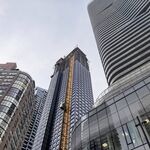Dan416
Senior Member
While I see the similarities between Don Mills stn and Sherway stn, in that they're both attached to malls, they're very different. Don Mills was not originally planned to be a terminus, it is now because that's where the funding was cut, and they chose the best point to finish with the funds they had. Sherway is not at the end of a stubway, it's at the end of a very successful line. And despite being the terminus of a stubway, Don Mills does very well at intercepting southbound commuters from the 404. This funnelling is likely the only reason why the Sheppard subway's ridership is anywhere near where it is. There's the same chance to do this with Sherway, intercepting people using the QEW who would otherwise continue along the Gardiner into downtown. Heck, during rush hour, taking the subway from Sherway to downtown may even be faster than sitting on the Gardiner.
In terms of connectivity to Sq1, I do support a subway eventually, but I think that in the short term, the connectivity of the Mississauga BRT to the Etobicoke Busway that's proposed in MoTo is a good start.
Personally I think the Mississauga BRT is a waste of money that won't really serve anyone in Mississauga anyway.
Sherway was under consideration in RTES and the extension to MCC follows naturally from that. That is why it should be on the SOS plan. How far in the future is irrelevant. It needs to be on there. If we're putting a DRL West (which really isn't needed) in Phase II, then the MCC extension needs to be there just as much.




